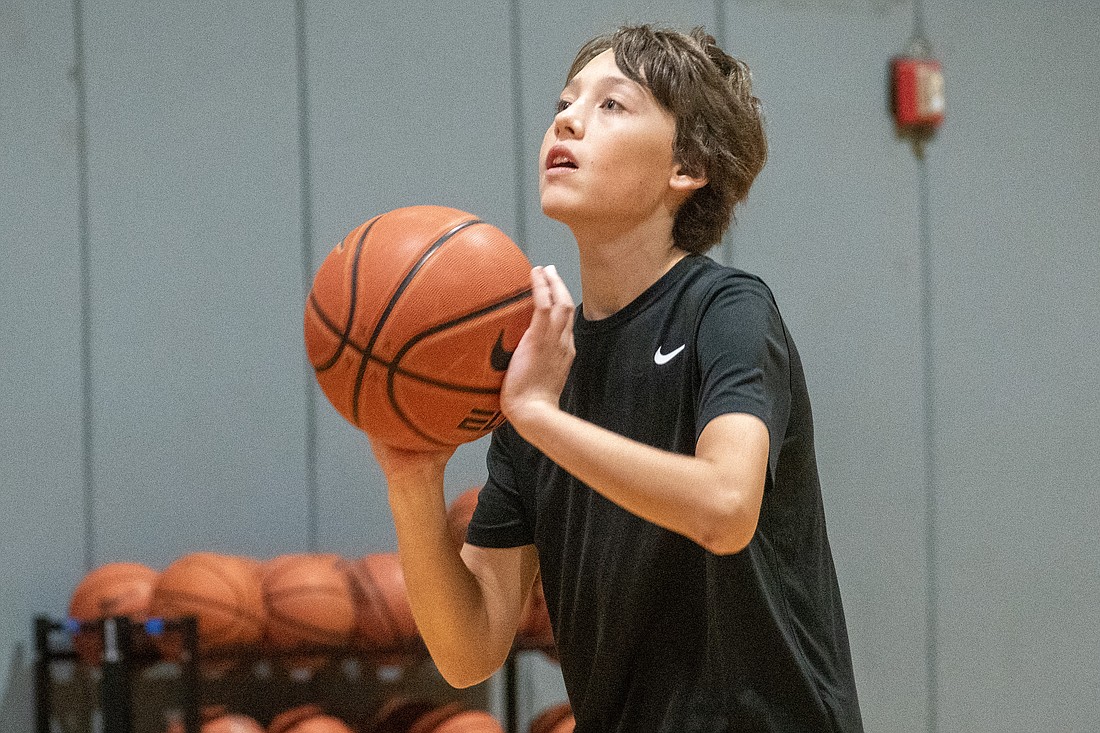- April 15, 2025
-
-
Loading

Loading

Are free throws the most backward-named skill in sports?
For something being marketed as an easy chance, a free throw is no sure thing. Just ask the best basketball players in the world. In the 2020s, NBA players have made 77.7% of their free throws, which means they are missing two to three times for every 10 times they step to the line. This percentage is only 4.5% higher than the mark of NBA players in the 1940s (72.5%).
In 80 years, these highest-caliber athletes have found no way to make the shot automatic. It remains a tricky practice, especially in pressure situations.
Well, the pressure was on Dec. 6 at Carlos E. Haile Middle. It was not NBA players taking shots from the line, but participants in the Elks Hoop Shoot, a national competition for boys and girls aged 8-13. This particular local competition was hosted by the Lakewood Ranch-Sarasota Elks Lodge.
The concept is simple. Each contestant gets five warm-up attempts before shooting 10 free throws that count. Once everyone else in their given age division gets a turn, players will get a second attempt — 15 shots with no warm-up. The scores of the two rounds are combined, and the winners move on to the next stage of the competition.

While the hoop shoot only lasted an hour and change, the gym was quiet for the entirety of it. The kids took it seriously — something that could be intimated by the looks on their faces while shooting. It surprised me while watching it, and it was equally surprising to some of the shooters, who found that turning free throws into a competition meant serious business.
"It was easier than I thought it was going to be," 11-year-old Daniel Ramirez said. "I don't usually make my free throws. Maybe it was the pressure that helped me."
Ramirez made 17 of his 25 free throws, or 68%, to win the Boys 10-11 division. It was the second-best mark of the night. Boys 12-13 winner Xavier Uhlinse made 20 of his 25 shots (80%) to lead the event.
Any time you're topping the NBA's average, you're doing all right. And the girls were no slouches either. They were led by Girls 8-9 winner Michelle Posada-Wilcher, who sank 15 of her 25 shots (60%).
Posada-Wilcher said she used an unusual technique to get ready for the event.
"I don't shoot at a basket," Posada-Wilcher said. "I just take a basketball and throw it at my wall."

Whatever works, works. Posada-Wilcher, for the record, also said her performance went better than she thought it would. But instead of crediting pressure, like Ramirez, she said she found it freeing to be alone on the line. Unlike during the flow of a basketball game, where there's usually an arm or two in your face while putting up a shot, free throws are open. Posada-Wilcher embraced that openness, and it led to success.
Some contestants had easier roads to the next stage than others. Girls 10-11 winner Claire Bullock needed to make just eight free throws, a feat she plans on improving a lot next time. She has a plan to do it, too.
"I practice every day, but only until I make three in a row," Bullock said. "This time, I'm going to practice until I make six in a row every day."
That's called challenging yourself. If Bullock sticks to that plan, her percentage at the next stage of the competition should increase. And it must as each stage comes with better shooters.
The event at Haile Middle was the local stage of the competition. The winners will participate in the district stage on Jan. 15 in Bradenton. If any of these winners advance again, they would move onto the state competition Feb. 19 at the Florida Elks Youth Camp in Umatilla. Then, regional and national competitions would await.
Regardless of how far these kids finish, I applaud them for trying something that might have been out of their comfort zone. When I was a young athlete, I participated in football's Punt, Pass and Kick national competition. I didn't advance to the district stage — as someone who mostly played fullback, the competition was not exactly tailored to my strengths — but I was glad I did it, because it showed those aspects of football to me in a new light and boosted my respect for punters and kickers.
The Elks Hoop Shoot could do the same thing for these kids. Free throws are often tossed aside when discussing a given players' ability, but they can decide the outcome of games. If a young basketball player gets free throw shooting down, they're going to impress their youth coaches and earn more playing time, particularly late in games. It's a valuable skill to learn now.
Of course, not everyone will improve. But if nothing else, I hope everyone involved got reminded of that age-old lesson.
Free throws are not free.